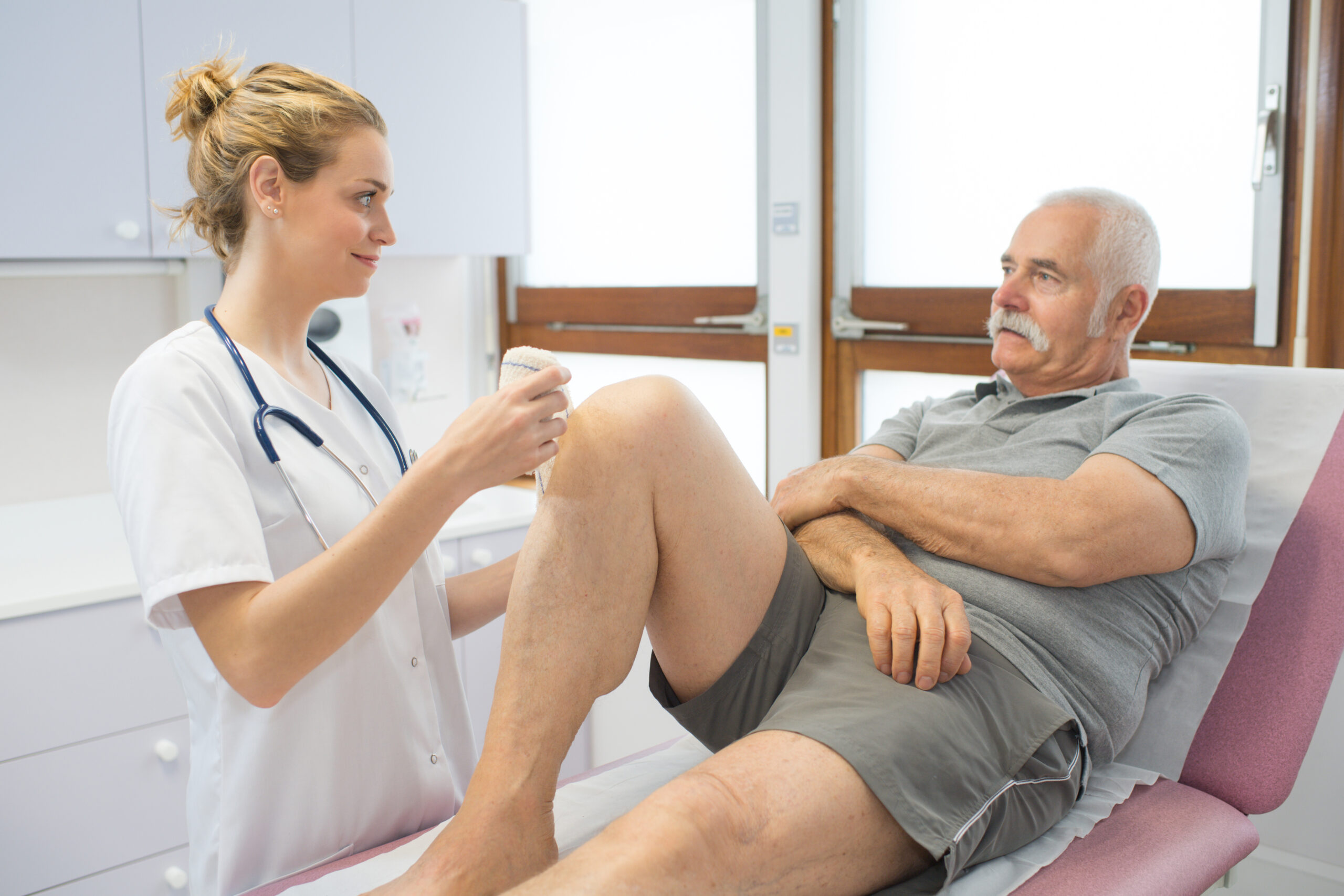Understanding Knee Osteoarthritis
According to the World Health Organization (WHO), 528 million worldwide were living with knee osteoarthritis in 2019. Of that number, 73 percent were over the age of 55 years old and 60 percent were women.
Knee osteoarthritis especially targets the knee joints. As the cartilage in the joint deteriorates, bones begin to rub against each other. This can cause pain and stiffness while reducing mobility. In fact, it’s a leading cause of disability – especially among older adults. As a result, this condition makes daily tasks like walking, climbing stairs or even standing for long periods challenging to do.

Types of Osteoarthritis
One of the first steps to understanding osteoarthritis is understanding the different types: primary, secondary, and post-traumatic. All three affect the same body parts, but have different causes.
Primary osteoarthritis, for example, doesn’t have any apparent underlying reasons for development. But secondary occurs after an abnormal amount of force is applied to the joint, traumatizing the cartilage. Post-traumatic osteoarthritis also develops from injury and trauma, but can be an early-onset condition. This can often make it more debilitating than primary osteoarthritis.
What are the Causes and Risk Factors?
There are multiple causes of knee osteoarthritis, including:
Age
As people get older, particularly after 45 years old, the risk increases. This is due to wear and tear on the joints, leading to cartilage breakdown.
Genetics
Like with many medical conditions, a family history of osteoarthritis can increase the likelihood of developing it.
Obesity
Individuals with excess weight have added stress on their joints, increasing cartilage deterioration and risk of osteoarthritis.
Joint Injury
If someone has had knee injuries like fractures or ligament tears, they can face a higher risk of osteoarthritis.
Repetitive Stress
Occupations or activities that require heavy use of the knees or heavy lifting can contribute to cartilage wear and tear, increasing the risk of osteoarthritis.
It’s important to note that multiple factors can be the cause of osteoarthritis in the knees. If you are concerned about your joint health, be sure to speak with your doctor about your worries and what prevention care may look like for you.
What are the Symptoms of Knee Osteoarthritis?
Depending on the severity of the arthritis, symptoms can vary. However, most people experience the following symptoms:
Pain
Aches and stiffness in the knee joints. This can worsen with physical activity or after long periods of rest.
Swelling
Knee osteoarthritis often causes inflammation in the joints, leading to noticeable swelling and discomfort.
Stiffness
Individuals suffering from osteoarthritis will often have difficulty moving their knee, especially after periods of rest or in the morning.
Limited Range of Motion
Depending on the severity of the arthritis, some people may have difficulty fully bending or straightening their knee joints.
Crepitus
Osteoarthritis can often cause a grinding or popping sensation within the knee during movement.
Remember, these symptoms and more can vary from person to person. But all of them can heavily impact daily life, and quality of life.
How Knee Osteoarthritis Impacts Daily Life
Because of its painful impact on the knee joints, people suffering from knee osteoarthritis can experience challenges in their daily lives. Some of these challenges include:
They can also experience more falls and injuries due to limited mobility and joint instability. These challenges significantly impact their quality of life, decreasing daily enjoyment and overall happiness.
Choose ClinCloud for Your Osteoarthritis Needs
If you are suffering from knee osteoarthritis, contact ClinCloud today to learn more about how our clinic trials and research can support your health needs. With us, you receive:
Diagnosing and Assessing Knee Osteoarthritis
Diagnosing and assessing knee osteoarthritis is a process that can involve multiple steps to accurately determine severity and treatment options.
First, a doctor will discuss your symptoms, risk factors, and relevant medical history. Next, they will examine your knee, looking at inflammation, joint instability, and limited movement.
If there is cause for concern, the next step will be imaging. This includes X-rays and MRIs. This is to confirm a diagnosis and to assess the extent of joint damage. Doctors may also request blood work to exclude other forms of arthritis, like rheumatoid arthritis and joint fluid tests to examine signs of inflammation or infection.
Treating Knee Osteoarthritis
There are three treatment paths available to people who are suffering from knee osteoarthritis. They are:
Non-Pharmacological
This includes weight management, exercise, physical therapy, wearing a knee brace, and applying hot-and-cold packs to relieve pain.
Pharmacological
This means using medications to help alleviate pain and inflammation. These medicines can be topical relief, over-the-counter medication, or prescriptions.
Surgical
This is considered when non-surgical options aren’t effective. Some surgical options are arthroscopy, osteotomy, and joint replacement.
To find the best treatment, it’s important to have transparent and open communication with your doctor so that the best treatment possible can be administered.
Emerging Therapies, Latest Research, and Future Directions
Knee osteoarthritis is a challenging condition. However, recent research shows promising and innovative treatment options. These treatment options include:
It’s important to note that these treatment options are still relatively new for osteoarthritis treatment, especially gene therapy, and come with a list of risk factors. This includes developing an infection, and having a negative immune system reaction.
The Present and Future of Osteoarthritis Treatment
Presently, clinical trials are exploring ways to advance knee osteoarthritis treatments. This involves researching effectiveness, optimal dosages, and the best delivery methods. These trials are also researching long-term benefits and limitations that are associated with these treatments.
With new treatment options emerging with promising results, the future of osteoarthritis treatment looks promising. It’s thanks to patients and individuals with knee osteoarthritis that innovative research is occurring, and continues to progress.
Participating in Clinical Trials for Knee Osteoarthritis
For people dealing with knee osteoarthritis, participating in clinical trials can be a beneficial way to receive treatment safely and effectively.
To participate, you should speak with your healthcare provider to determine whether a trial is suitable for you. Also, be sure to check eligibility requirements, which can include age, osteoarthritis severity, and overall health.
Why are Clinical Trials Important?
Clinical trials are vital for advancing treatments. They help to develop new treatments, evaluate the safety of existing ones, and explore innovative approaches.
Enrolling in Clinical Trials
Participating in clinical trials usually involves multiple steps, including:
While it may seem like a long process, these steps are in place to ensure that you are safe and that each clinical trial suits your medical needs.
Match with ClinCloud for Clinical Trials
At ClinCloud, we offer clinical trials that are innovative for osteoarthritis treatment. If you are located in the Orlando and Melbourne, Florida areas, contact us to connect with clinical trials in your area!
Ongoing trials that researchers are conducting include a wide variety of treatments, including:
Ready to Get Started on a New and Innovative Treatment Journey?
Helping Friends and Family with Knee Osteoarthritis
If you have a loved one dealing with knee osteoarthritis, it can be difficult to watch. But there are steps you can take to offer them support and help!
If your loved one needs community, you can share information about support groups, educational materials, clinical trials, and online communities about knee osteoarthritis. These resources can include:
- The Arthritis Foundation
- American Academy of Orthopaedic Surgeons
- National Institute of Health
- Local support groups and physical therapy services in your area
With these steps, your loved one will feel supported and well cared for with you by their side.

